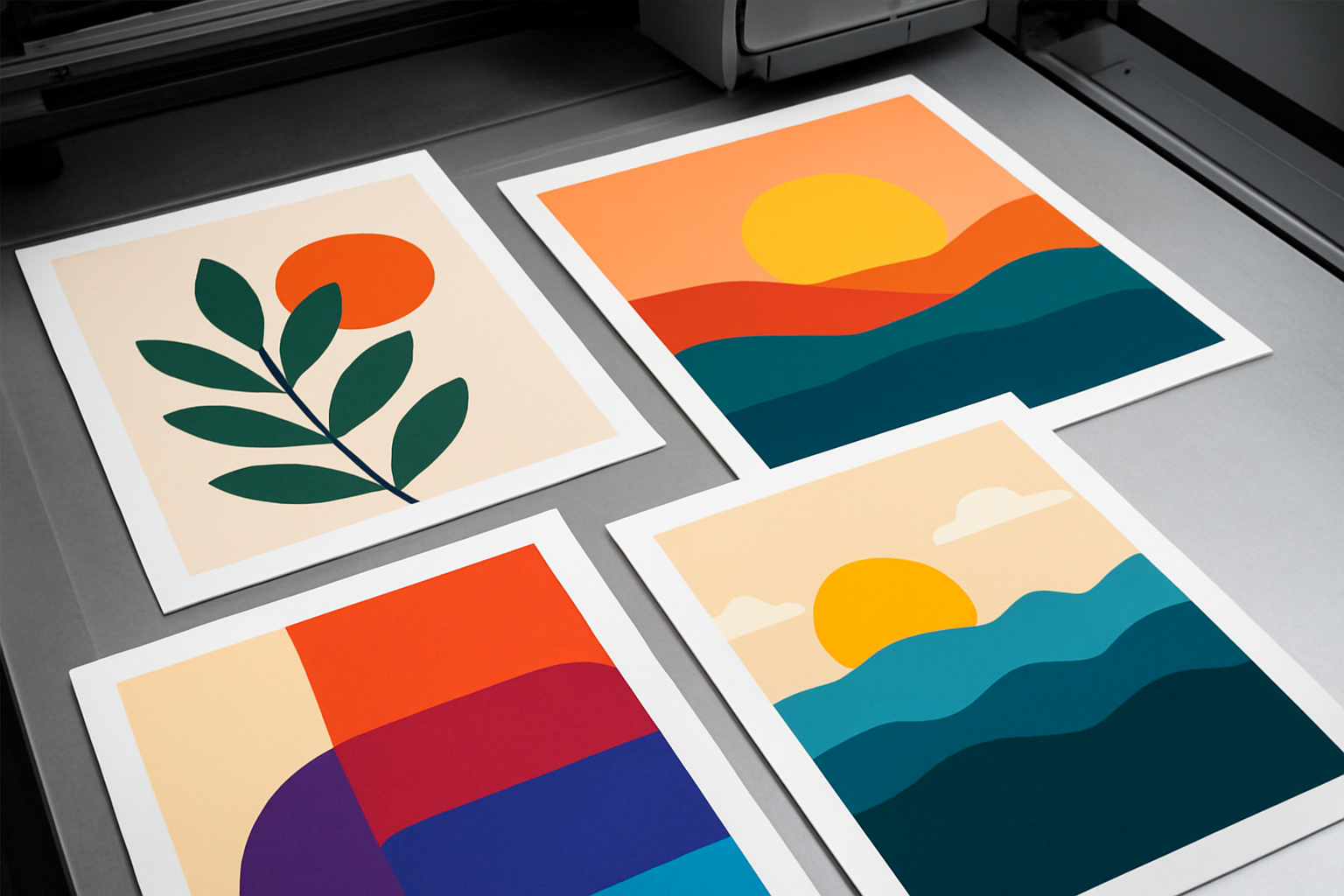How To Install a Custom Statue?
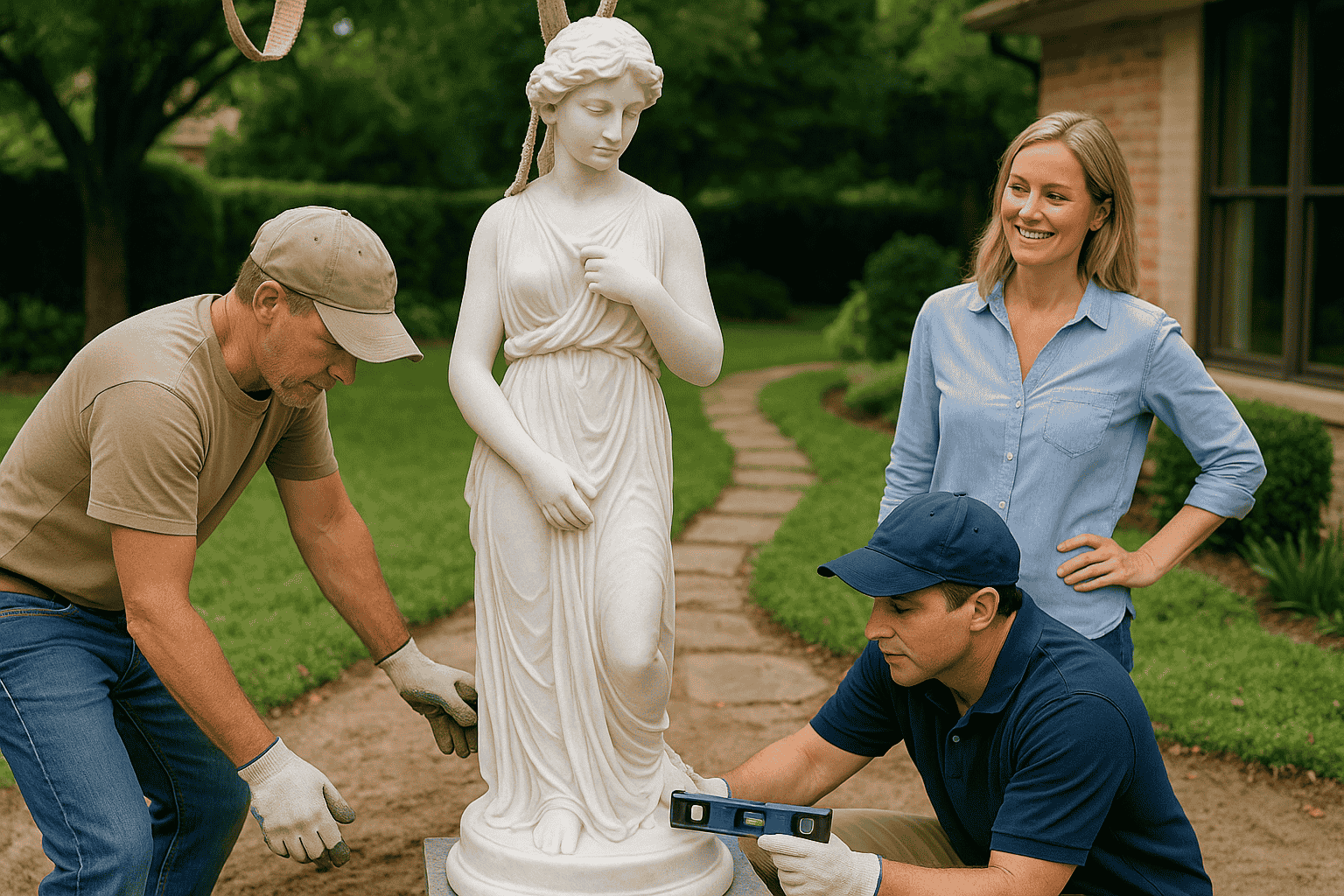
Installing a custom statue is an exciting moment. It adds beauty, meaning, and personality to any space. However, to ensure it remains both secure and visually appealing for many years, proper installation is essential. A single misstep could result in a scratch, crack, or even more damage.
Every material is different. Bronze is strong but needs care. Fiber is light but sensitive to the weather. Marble and sandstone are beautiful but heavy and fragile. This guide will help you do just that with clear and simple steps.
What to Prepare Before You Begin Statue Installation?
Preparing your tools and workspace ahead of time is key to a smooth and safe statue installation. A little planning can help prevent accidents and damage during unboxing or placement.
Essential Tools You’ll Need
- Safety gloves to protect your hands and the statue’s surface
- Hammer and pry bar for opening the crate
- Pliers to remove nails or staples from the packaging
- Soft cloth for gently wiping off dust or packing residue
Optional Equipment for Heavy Statues
- Hand truck for mid-weight statues that need to be rolled into place
- Hydraulic lift for larger, heavier pieces that need to be raised vertically
- Forklift with padded forks for statues made of marble or sandstone that require extra care during handling
Prepare the Installation Area
- Choose a clean, flat, and stable surface to unpack the crate
- Set up as close as possible to the statue’s final location to reduce unnecessary lifting or shifting
- Make sure there’s enough room for people or equipment to move safely around the area
Manpower Planning
- Statues vary widely in weight. Some can be lifted by two people, while others may need a full crew or mechanical support.
- Check the material and size before unboxing and decide in advance how many people or what kind of support you’ll need.
Proper prep avoids common mishaps like chips, cracks, or strained backs. It's worth a few extra minutes upfront.
Unpacking the Custom Statue: Step-by-Step
Unpacking is the first hands-on moment with your custom statue. This is where careful handling matters most. Follow these steps to make sure everything stays safe and secure.
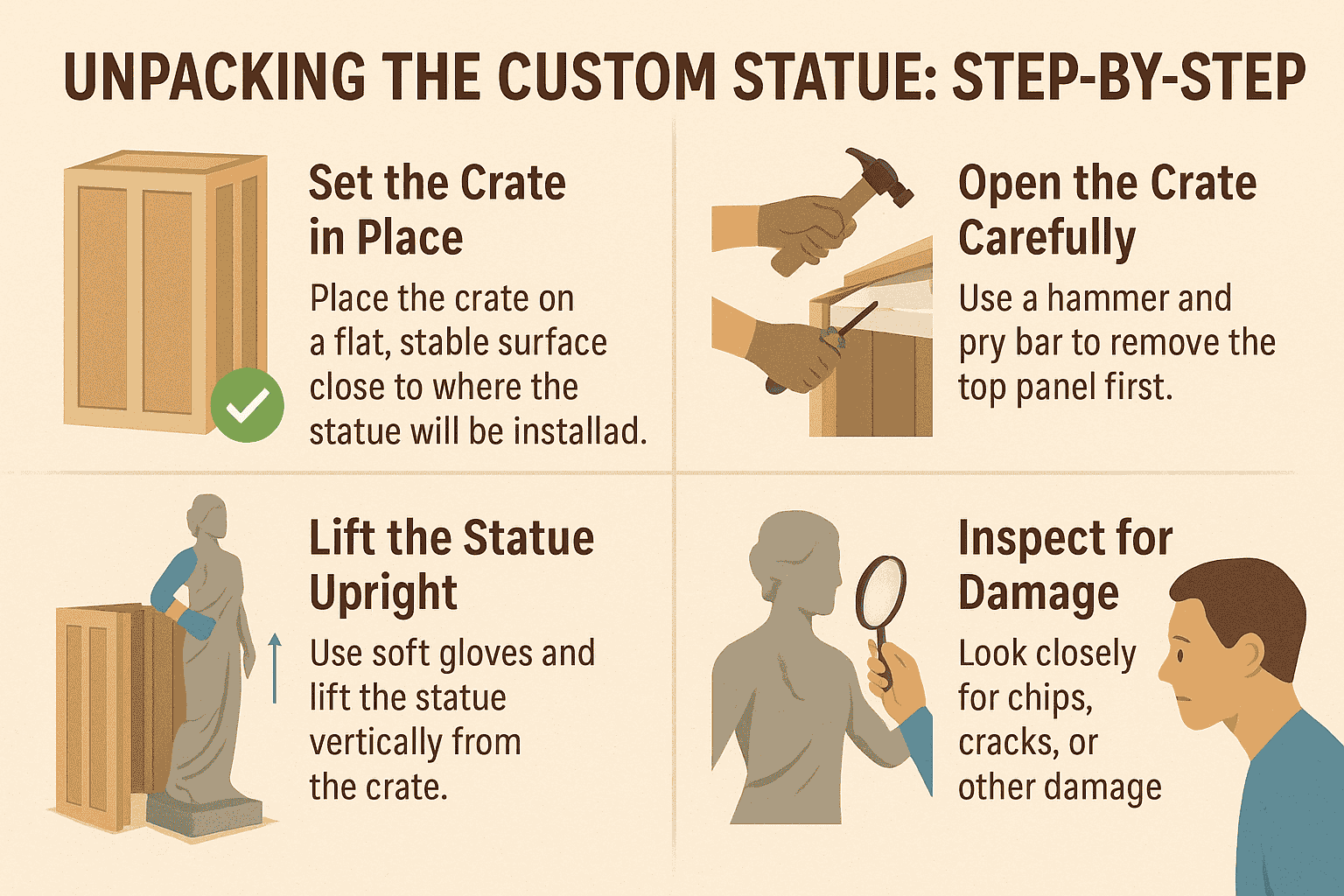
1. Set the Crate in Place
Place the crate on a flat, stable surface close to where the statue will be installed. Avoid uneven flooring or soft ground that could cause the crate to shift while you open it.
2. Open the Crate Carefully
Use a hammer and pry bar to remove nails or staples from the top. Take off the top panel first, then slide away the sides without forcing them. Work slowly to avoid putting pressure on the statue inside.
3. Lift the Statue Upright
Once exposed, lift the statue vertically and from the base. Never tilt or drag it out of the foam or crate. Use soft gloves for grip and protection. Watch out for extended parts like hands or edges that may be delicate.
4. Inspect for Damage
Before placing the statue, check it from all angles. Look for chips, cracks, or loose details that might have happened while moving the statue. Don’t proceed with installation if you notice any damage.
Never drag a statue across the floor, especially if it’s made of marble, sandstone, or heavy fiber. These materials can crack or chip even with a small shift.
Instead, use a hand truck, moving dolly, or forklift with padded forks to safely move the statue to its final spot. For smaller pieces, a two-person lift works well if handled from the base.
Material-Wise Statue Installation Guide
Different materials require different installation approaches. Factors like weight, durability, and surface sensitivity all play a role in how each statue should be handled. Below is a complete guide based on the most common custom statue materials: Bronze, Fiberglass, and Marble/Sandstone.
Bronze Statues
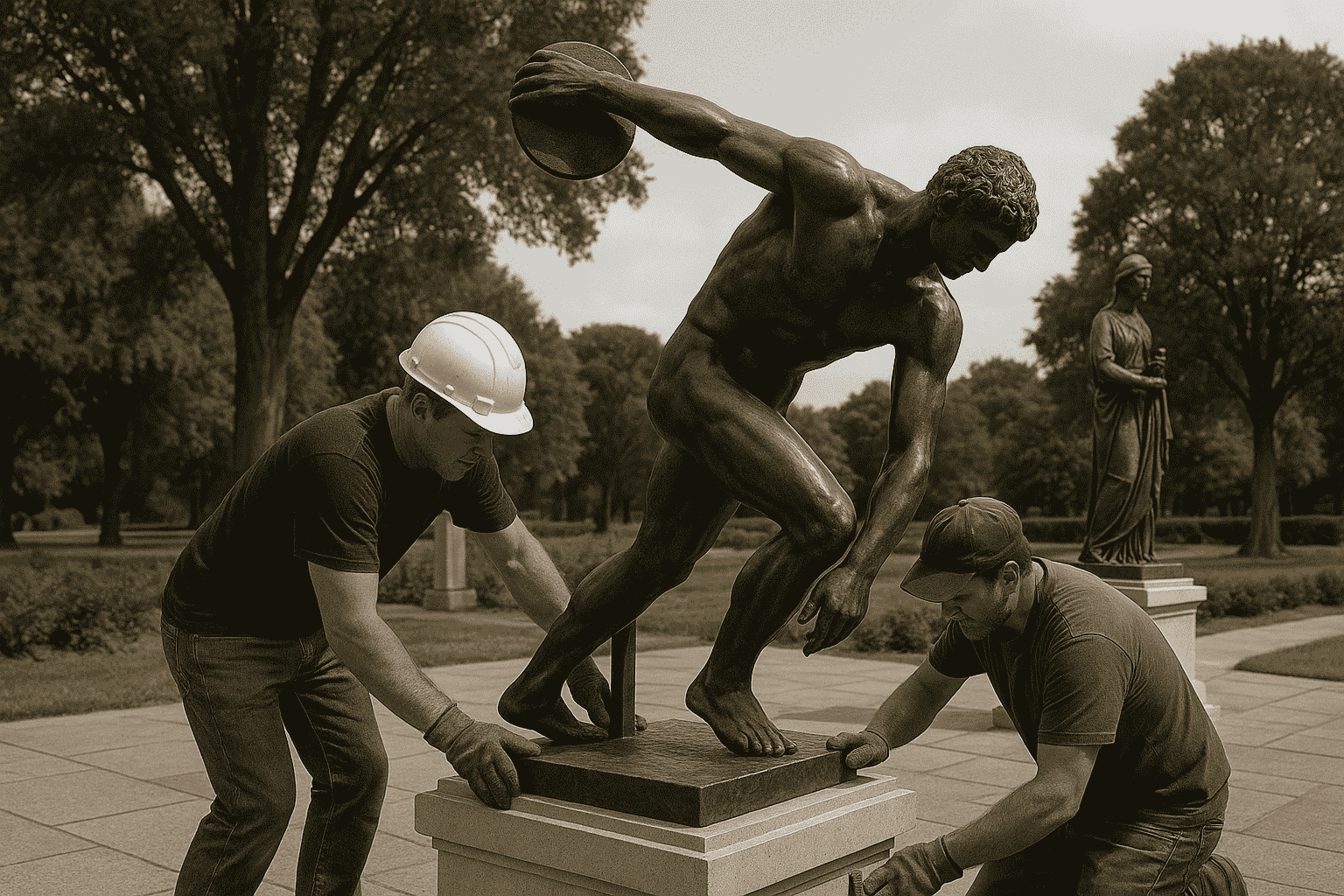
Installation Notes:
- Place on flat, stable ground (indoor or outdoor)
- Suitable for all-weather conditions
- Can be positioned directly on pedestals, floors, or concrete bases
Handling & Tools:
- Weight range: 15 to 750 lbs
- Use a two-person lift for smaller sizes
- For heavier pieces, use a hand truck or forklift with padded forks
Care Tips:
- Wipe with a soft cloth regularly
- Apply a thin coat of wax every few months to preserve patina and prevent corrosion
Fiberglass Statues
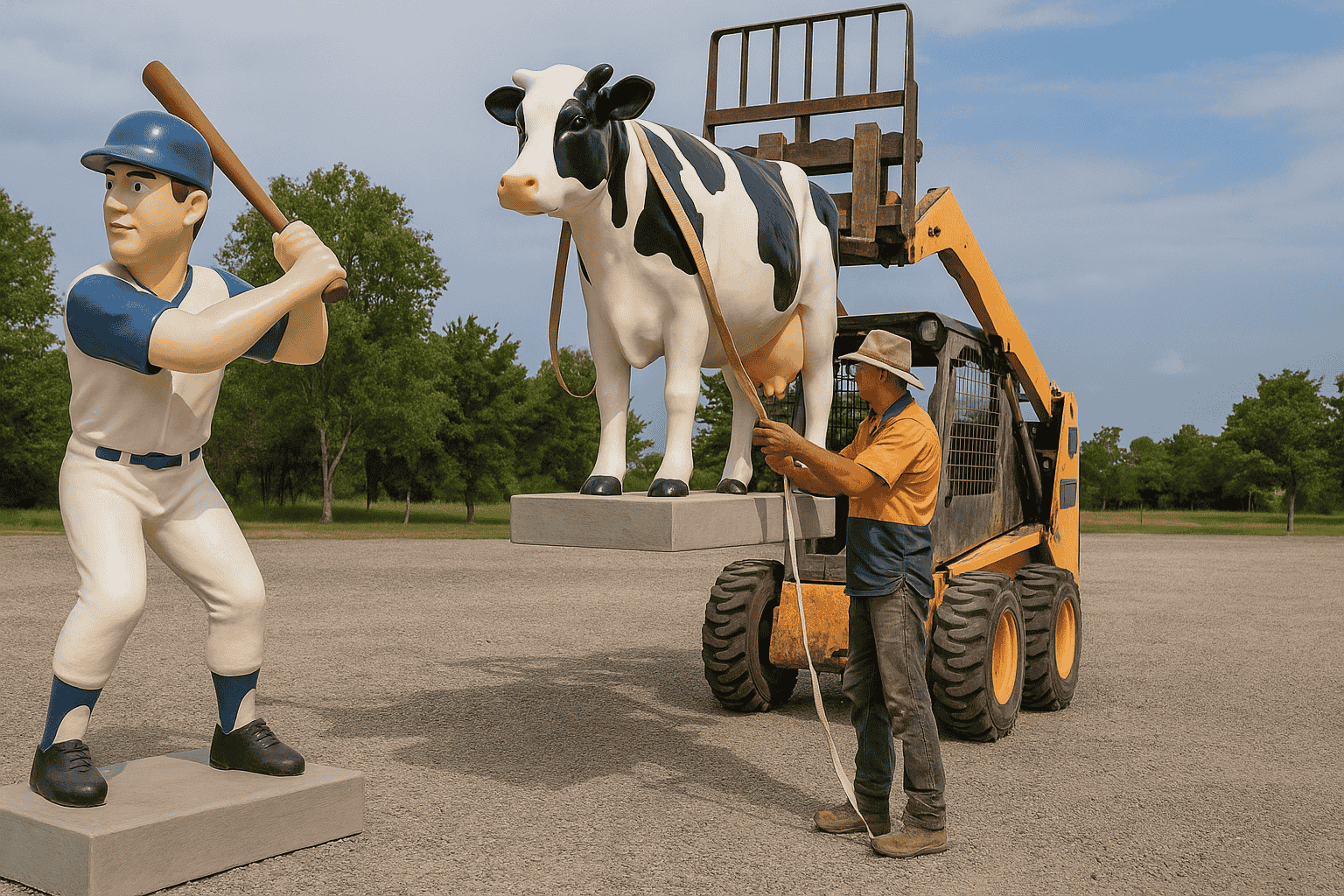
Installation Notes:
- Ideal for both indoor and outdoor display
- Avoid prolonged exposure to direct sunlight and moisture
- Place on dry, even surfaces like patios, tiles, or platforms
Handling & Tools:
- Weight range: 8 to 350 lbs
- Smaller pieces: 2–3 person lift
- Larger pieces: use a forklift for safe movement
Care Tips:
- Clean with mild soap and water only
- For outdoor use, apply a UV-resistant sealant to prevent fading or cracking
Marble & Sandstone Statues

Installation Notes:
- Best displayed on stone or concrete foundations
- Avoid soft surfaces like grass or gravel
- Keep surface level and free from standing water
Handling & Tools:
- Weight range: 33 to 1433 lbs
- These statues are heavy and fragile
- Always use a hydraulic lift or forklift with padded forks
- Never drag or tilt the statue while lifting
Care Tips:
- Use only a damp, soft cloth for cleaning
- Avoid any acidic or abrasive chemicals
- Apply a stone sealant once a year if placed outdoors to protect against moisture, algae, and dirt buildup
Final Placement Tips
After unpacking and lifting the statue, placing it correctly is the last but most important step. The right base and surroundings can protect the statue and bring out its best look.
Make Sure the Surface is Level
A flat and stable surface keeps the statue balanced and reduces the risk of tipping or leaning. Use a spirit level if needed.
Choose a Strong Base
- Indoor: Hardwood, tile, or marble flooring works well
- Outdoor: Use concrete, stone slabs, or a pre-built pedestal
- Avoid grass, soil, or gravel — they shift over time and can cause cracks or uneven pressure
Use Felt or Anti-Slip Pads (Indoors)
Place soft pads under the base to protect floors and help the statue stay in place.
Protect Against Weather (Outdoors)
- Make sure there’s no standing water around the base
- If needed, build a slightly raised platform to improve drainage
- Place the statue in a spot with some shade or partial cover if it’s made of fiberglass or sandstone
Secure the Statue if Needed
For tall or heavy statues, especially outdoors, use anchor bolts or brackets to secure the base. This adds extra safety in areas with wind, foot traffic, or pets.
Conclusion
A well-installed statue looks beautiful and lasts longer. Take it slow, use the right tools, and handle it with care. That’s all it takes to get it right.
Key Takeaways: Installing a Custom Statue
- Place the crate on a stable surface near the final spot
- Use safety gloves, a hammer, and a pry bar to open the crate carefully
- Lift the statue straight up from the base without tilting
- Never drag the statue, especially if it's marble or sandstone
- Use a hand truck, lift, or forklift based on the statue’s weight
- Set the statue on a level and solid surface like concrete or stone
- Add felt or anti-slip pads for indoor placements
- Check for balance and secure the statue if needed before walking away







